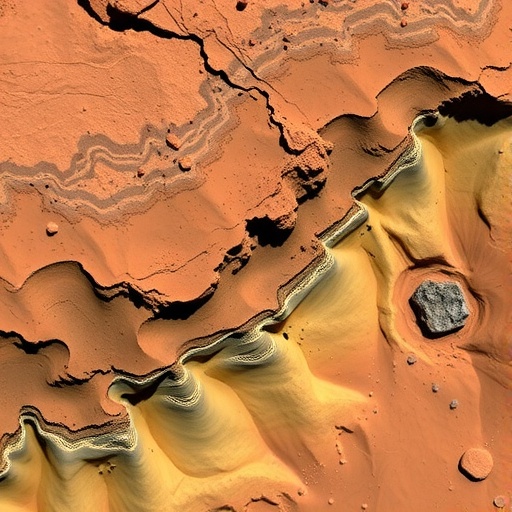In a groundbreaking study, scientists have unveiled intriguing insights into the subsurface structure of Mars, specifically under the InSight lander. Utilizing sophisticated geophysical techniques, the research provides substantial evidence of subsurface fluvial sediments, suggesting a dynamic history of water and sediment transport on the Martian surface. This revelation not only enhances our understanding of Mars’ geological history but also raises questions about its climatic evolution and potential habitability.
The InSight lander, which has been on the Martian surface since 2018, has been tasked with studying the planet’s interior. Equipped with a suite of instruments, including a seismometer and a heat probe, InSight has gathered pivotal data that allowed researchers to reconstruct the subsurface geology. The study, led by scientists including Xiao and Carrasco, takes a significant leap in interpreting seismic waves to reveal structures previously hidden beneath the Martian regolith.
Drilling down into the data, the research highlights that these fluvial sediments found beneath the surface could offer vital clues about the ancient Martian environment. Analysis of seismic data, in particular, provided insights into how these sediments were deposited and subsequently altered over time. The implications suggest that water once flowed freely across the Martian landscape, potentially creating habitable environments for microbial life.
Crucially, the study indicates that these sediments are not just randomly distributed; they reveal patterns consistent with past river channels and floodplains. This finding suggests that there were periods in Mars’ history when liquid water was abundant, which could have played a significant role in shaping the planet’s geological features. The identification of such fluvial features deep beneath the surface opens new avenues for understanding Mars’ climatic history and its potential capacity to support life.
Moreover, the research emphasizes the importance of using advanced geophysical techniques, including wave propagation analysis, to glean information about the Martian crust. By examining how seismic waves travel through different materials, scientists can infer the composition and structure of subsurface layers. This methodology has proven instrumental in revealing the complexity of Mars’ geology.
The implications of these findings extend beyond academic interest; they offer a roadmap for future exploration missions to Mars. Understanding the location and nature of these subsurface sediments may help inform landing site selection for future missions, ultimately enhancing our chances of discovering signs of past life. Scientists are particularly interested in examining these sedimentary environments closer, as they are prime candidates for harboring biosignatures.
Additionally, the presence of subsurface water ice, possibly associated with these sediments, poses significant questions about the current availability of water resources on Mars. Water is a critical element for any future human exploration missions, making the identification of accessible water sources a top priority for researchers. The knowledge gleaned from this study could inform technologies and strategies for resource utilization on Mars.
As researchers continue to analyze the findings from the InSight lander, there is hope that further investigations can reveal more about Mars’ enigmatic past. Each revelation is a piece of the puzzle that could illuminate the history of water on Mars and its potential to support life forms. Scientists bridge a connection between geological processes observed on Earth and the similar, yet distinct, processes that have shaped Mars.
A key takeaway from this research is the confirmation that Mars was once a much wetter planet than we see today. This realization is exhilarating, as it reshapes our understanding of the Red Planet’s climate and raises the possibility that life could have existed in its ancient rivers and lakes. The sensational nature of these discoveries captures the imagination and drives further inquiries into Mars’ potential for life—past, present, or future.
Furthermore, the techniques employed in this study serve as a model for how we approach extraterrestrial geology. The interdisciplinary collaboration between seismologists, geologists, and planetary scientists highlights the necessity of combining expertise to tackle complex scientific questions. This collaborative spirit fosters an environment where innovation thrives, enabling researchers to develop new methods and technologies for future missions.
As the world eagerly follows the ongoing discoveries related to Mars, this research underscores the importance of sustained investment in planetary exploration. The need for continued funding and resources becomes increasingly apparent, especially as we aim to expand our understanding of not just Mars, but other celestial bodies within our solar system. The study by Xiao and colleagues is a testament to what we can achieve through perseverance and dedication to science.
In conclusion, the research detailing the subsurface fluvial sediments beneath InSight on Mars marks a significant milestone in planetary science. It propels us closer to answering critical questions about our neighboring planet’s history and the ongoing search for extraterrestrial life. As we gather more pieces of this complex cosmic puzzle, the scientific community remains fervently optimistic about the possibilities that lie ahead on Mars.
This remarkable study not only enhances our comprehension of Mars’ geological features but also ignites excitement for ongoing explorations that promise to reshape our understanding of the universe itself. Each discovery beckons the scientific community, helping us to unravel the mysteries of the cosmos. As we stand on the brink of new discoveries, the quest for knowledge about Mars continues, revealing potential past environments where life could have thrived.
Subject of Research: Subsurface fluvial sediments beneath InSight on Mars
Article Title: Subsurface fluvial sediments beneath InSight on Mars from geophysical constraints
Article References:
Xiao, W., Carrasco, S., Xu, Z. et al. Subsurface fluvial sediments beneath InSight on Mars from geophysical constraints. Commun Earth Environ 6, 784 (2025). https://doi.org/10.1038/s43247-025-02777-1
Image Credits: AI Generated
DOI: 10.1038/s43247-025-02777-1
Keywords: Mars, InSight lander, geophysical techniques, subsurface sediments, planetary exploration, ancient water, geological history




